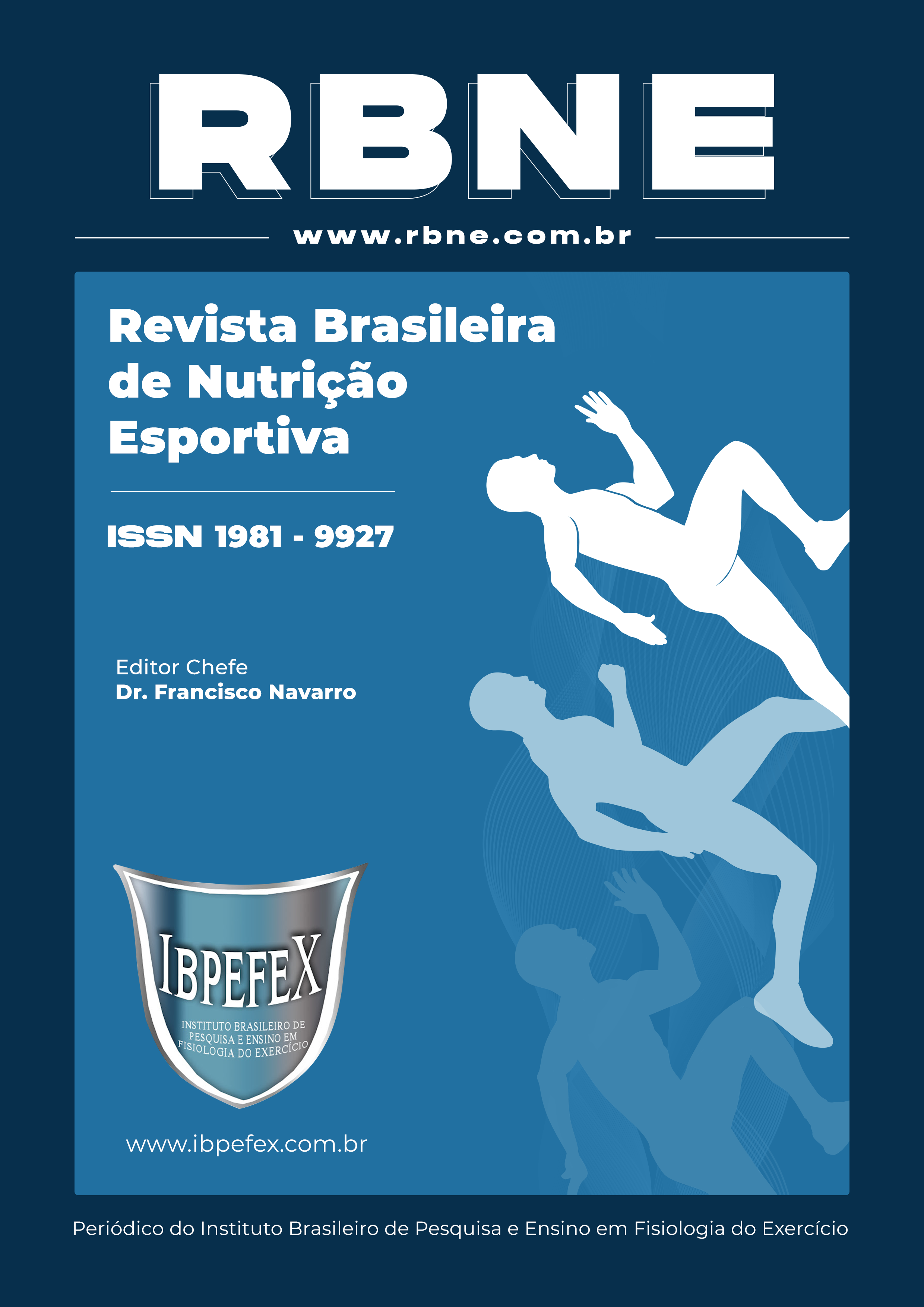Glycemia evaluation after oral overload of powder sweet potato, maltodextrin or waxy maize
Abstract
Introduction and Objective: Powder sweet potato has been introduced in the Brazilian market as a supplement source of slow absorption carbohydrate, however, there are no studies showing the glycemic response provided by it is unknown. Thus, the purpose of this study is to avaluate the two-hour glycemia, after the consumption of powder sweet potato supplement and compares it with maltodextrin and a waxy maize. Materials and Methods: Eleven subjects ingested 75 g of carbohydrate from powder sweet potato (BD), maltodextrin (MD) or waxy maize (WM) at different times. Fasting blood glucose was measured and at 15, 30, 45, 60, 90 and 120 minutes after ingestion. The difference between the glycemia means of each condition and over time was analyzed through the ANOVA test for repeated measures. Results: BD consumption demonstrate a different glycemic response to MD at moments 15, 30 and 45 minutes (p <0.01). There was no difference between BD and WM. Conclusion: The two-hour glycemia, resulting from the consumption of powder sweet potato is lower than that obtained by maltodextrin, but similar to that of waxy maize.
References
-Acheson, K.J.; Blondel-Lubrano, A.; Oguey-Araymon, S.; Beaumont, M.; Emady-Azar, S.; Ammon-Zufferey, C.; Monnard, I.; Pinaud, S.; Nielsen-Moennoz, C.; Bovetto, L. Protein Choices Targeting Thermogenesis and Metabolism. Am J Clin Nutr. Vol. 93. Num. 3. 2011. p. 525-34
-Allen, J.O.; Corbitt, A.D.; Maloney, K.P.; Butt, M.S.; Truong, V.D. Glycemic Index of Sweet Potato as Affected by Cooking Methods. The Open Nutri Jour. Vol. 6. 2012. p. 1-11.
-Alves, R.J.; Kitayama, T.YM.; Fujimoto, C.Y.; Franken, R.A. Estudo Amostral das Influências das Fases Folicular e Lútea do Ciclo Menstrual no Perfil Lipídico. Arq Med Hosp Fac Cienc Med Santa Casa São Paulo. São Paulo. Vol. 60. 2015. p. 16-21.
-Baganha, R.J.; Santos, G.F.S.; Moreira, R.A.C.; Tiburzio, A.S.; Macedo, R. Diferentes Estratégias de Suplementação com Carboidrato e Subsequente Resposta Glicêmica Durante Atividade Indoor. Revista da Educação Física/UEM. Vol. 19. Num. 2. 2008. p. 269-274.
-Bahado-Singh, P.S.; Riley, C.K.; Wheatley, A.O.; Lowe, H.I.C. Relationship Between Processing Method and the Glycemic Indices of Ten Sweet Potato (Ipomoea batatas) Cultivars Commonly Consumed in Jamaica. Journ of Nutri and Metabol. Vol. 2011. 2011
-Burke, L.M.; Hawley, J.A.; Wong, S.H.S.; Jeukendruo, A.E. Carbohydrates for Training and Competition. Journal of Sports Sciences. Vol. 29. Num. 1. 2011. p. S17-S27.
-Close, G.L.; Hamilton, L.; Philp, A.; Burke, L.M.; Morton,J.P. New Strategies in Sport Nutrition to Increase Exercise Performance. Free Rad Biol and Med. Vol. 98. 2016. p. 144-158.
-Cordeiro, N.; Feiras, N.; Faria, M.; Gouveia, M. Ipomoea batatas (L.) Lam.: A Rich Source of Lipophilic Phytochemicals. J Agric Food Chem. Vol. 61. Num. 50. 2013. p. 12380-12384.
-DeMarco, H.M.; Sucher, K.P.; Cisar, C.J.; Butterfield, G.E. Pre-Exercise Carbohydrate Meals: Application of Glycemic Index. Med & Sci in Sports & Exer. Vol. 31. Num. 1. 1999. p. 164-170.
-Dincer, C.; Karaoglan, M.; Erden, F.; Tetik, N.; Topuz, A.; Ozdemir, F. Effects of Baking and Boiling on the Nutritional and Antioxidant Properties of Sweet Potato [Ipomoea batatas (L.) Lam.] Cultivars. Vol. 66. 2011. p. 341-347.
-Jeukendrup, A. A Step Towards Personalized Sports Nutrition: Carbohydrate Intake During Exercise. Sports Med. Vol. 44. Num. 1. 2014. p. S25-33.
-Lehmann, U.; Robin, F. Slowly Digestible Starch and Its Structure and Health Implications: a Review. Trends in Food Sci & Technol. Vol. 18. 2007. p. 346-355.
-Neufer, P.D.; Costill, D.L.; Fink, W.J.; Kirwan, J.P.; Fielding, R.A.; Flynn, M.G. Effects of Exercise and Carbohydrate Composition on Gastric Emptying. Med Sci Sports Exerc. Vol. 18. Num. 6. 1986. p. 658-62.
-Pannoni, N. The Effect of Various Carbohydrate Supplements on Postprandial Blood Glucose Response in Female Soccer Players. Dissertação de Mestrado. University of South Florida. Tampa. 2011.
-Sands, A.L.; Leidy, H.J.; Hamaker, B.R.; Maguire, P.; Campbell, W.W. Consumption of The Slow-Digesting Waxy Maize Starch Leads to Blunted Plasma Glucose and Insulin Response but Does Not Influence Energy Expenditure or Appetite in Humans. Nutrition Research. Vol. 29. Num. 6. 2009. p. 383-390.
-Stellingwerff, T.; Cox, G.R. Systematic Review: Carbohydrate Supplementation on Exercise Performance or Capacity of Varying Durations. Appl Physiol Nutri Metabol. Vol. 39. Num. 9. 2014. p. 998-1011.
-Taylor, C.; Higham, D.; Close G.L.; Morton, J.P. The Effect of Adding Caffeine to Postexercise Carbohydrate Feeding on Subsequent High-Intensity Interval-Running Capacity Compared with Carbohydrate Alone. Int J Sport Nutr Exerc Metab. Vol. 21. Num. 5. 2011. p. 410-6.
-Wong, S.H.; Chan, O.W.; Chen, Y.J.; Hu, H.L.; Lam, C.W.; Chung, P.K. Effect of Preexercise Glycemic-Index Meal on Running When Cho-Electrolyte Solution is Consumed During Exercise. Int J Sport Nutr Exerc Metab. Vol. 19. Num. 3. 2009. p. 222-42.
Copyright (c) 2023 Yasmin Negrão Rufini

This work is licensed under a Creative Commons Attribution-NonCommercial 4.0 International License.
Authors who publish in this journal agree to the following terms:
- Authors retain the copyright and grant the journal the right of first publication, with work simultaneously licensed under the Creative Commons Attribution License BY-NC which allows the sharing of the work with acknowledgment of the authorship of the work and initial publication in this journal.
- Authors are authorized to enter into additional contracts separately for non-exclusive distribution of the version of the work published in this journal (eg, publishing in institutional repository or book chapter), with acknowledgment of authorship and initial publication in this journal.
- Authors are allowed and encouraged to post and distribute their work online (eg, in institutional repositories or on their personal page) at any point before or during the editorial process, as this can bring about productive change as well as increase impact and impact. citation of published work (See The Effect of Free Access).






